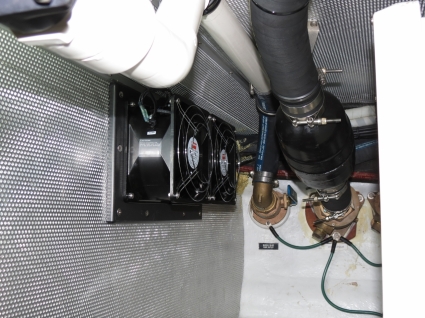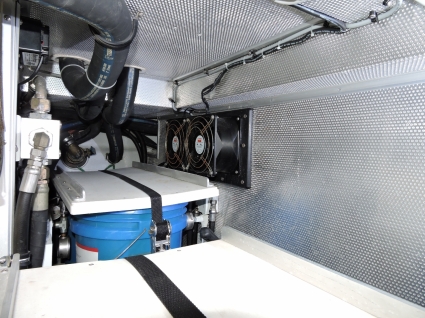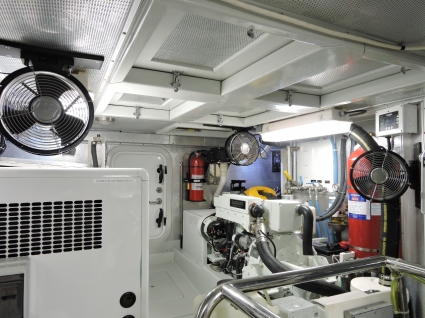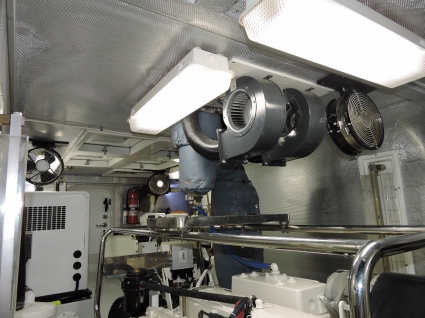Excess engine room temperatures are hard on the equipment and tough on the people. Engine room checks end up less detailed and, if you need to do emergency service, it can become a safety problem. We are all sufficiently motivated to want lower engine room temperatures but its actually not that easy. Engine room temperature specifications from engine manufacturers are either specified as no more than a specific absolute temperature or they specify a deltaT. This latter specification is referring to the allowable amount warmer the engine room can be over the ambient outside temperature. Our engine, a John Deere 6068AFM75, requires a deltaT of no more than 30F. Essentially, that means that the engine room temperature is never more than 30F higher than the outside temperature.
Cooling an engine room sounds easy but, on a trawler, the hot engine is nestled away just above the bilge surrounded by insulating fuel tanks and living spaces. It can take hours to even days for the engine room temperatures to fully develop and max out. Many times we thought we had cooling design changes that worked only to learn that, if we ran for a few more hours, we would still end up considerably hotter than the 30F deltaT goal. With stubbornness we did find a workable solution even when operating 24×7 for days in the tropics. What we learned is that cooling is a black art, “obviously right” answers sometimes can be counter-productive and, even some very small changes can have a very large impact.
The eventual solution centered around the observation that we had great engine room air intakes but inadequate exhaust outlet area. If the air can’t get out, new air can’t come in, and it’s flow that cools the engine room. It’s also important to avoid negative pressure which is bad for the engine and positive pressure which can force engine room air into the house. Dirona has 3-inch ducts at either side at the front of the engine room, and a 3-inch duct up the engine room stack. These would seem sufficient, but even after upgrading the exhaust fans on all three, we had made close to zero progress towards the goal. It’s very difficult to efficiently get enough flow through these three small air ducts, two of which have a circuitous routing to the outside that further reduces flow. The secondary problem is the system has the intakes at the back, but the heat producer, the engine, is at the front of the engine room. The back of the engine room was always much cooler than the front.
The first change we made was to convert the port side intake (left below) to an exhaust, and keep the starboard side air intake as is (right below). The starboard side pushes air forward and the port side pushes it aft. We powered both with a bit more than 700 CFM of active fans on each side. This brought the back of the engine room to near ambient, and the front was much improved, but still not good enough.

|

|
The next step was to set up a rotation of the air in the engine room by putting large axial fans circulating the air forward along the port side and aft along the starboard side. This ensures the cold air doesn’t short-circuit out the exhaust but has to travel forward to the front of the engine room which is the hottest area on Dirona.

|

|
The last step we took was to experiment with the exhaust fans for the small 3″ ducts on each side of the front of the engine room. We ran for days at a time with them on and off. They consumed power, but didn’t impact the engine room temperature, so we took them both out. The stack blower still is needed to keep the stack cooler.
For air moving, we are using three types of fans: 2 Dayton 1TDR7 for the stack blower, 4 Dayton 4WT44 for circulation and 4 Dayton 3VU66 (2 on each side) for intake and exhaust. Note you do need to seal off the around the air intake and exhaust fans. We mounted them to black marine board and then attached them to the bulkhead, sealing off the intake and exhaust. The circulation fans also are mounted to black marine board using mounts from Sure Marine in Seattle .

|

|
While we did go through seven or eight different design ideas and implementations to get there, overall, we think the engine room temperature issue was worth solving. It’s better for the mechanical equipment and it’s better for us. As an additional level of protection, in the case longer service operations are required in hot climates, we also have a large floor-standing industrial air mover we can deploy wherever it’s needed. We use this when working in a hot engine room or lazerette for extra cooling, to provide extra cooling for the SCUBA compressor in hot climates, and sometimes for moving air to cool the house when we aren’t using the air conditioning. It was also useful in experimenting with different flow patterns in the engine room.
If you have high engine room temperature, the first place to look is where is the heat coming from? Make sure the exhaust cladding is of good quality and not letting too much heat escape into the engine room. Once you are sure the boat is not dumping excess heat, the next solution is air flow. And, when looking at air flow, it’s truly amazing how much air flow is required to provide adequate cooling. In the tropics, even with these changes, the engine room falls short of a popular place for cocktails when underway but it’s actually comparatively comfortable for engine room checks and is much safer if longer duration service work is required.

The stacked fans are not high CFM fans. I would look for either an axial or radial fan, or perhaps a squirrel cage blower. The squirrel cage will be quieter with high cfm than the other two.
stu
Correct, those two stack fans are not part of the engine cooling system. One of those fans blows up the void between the inner stack that carries the hot exhaust gases and the outer stack that provides an air void of heat insulation. By blowing up through the void spaces, the outer stack is kept cooler. The other fans is blowing up the space between the outer stack and the insulated chimney. This could provide real air moving from ER cooling but, as you point out, the air mover is not very effective so it really doesn’t do much. I intend to remove this unit and replace it with axial fans in the top of the stack but, at this point, it does almost nothing so it is effectively not part of the ER cooling system.
How much did you spent on this system ?
Most of the cost is the time to find a design that actually works. The cost of the fans run $50 to $100 each so the equipment deployed doesn’t really cost very much even in aggregate.
Very interesting on the heat challenges. Curious now where you are headed now (1130 PDT 5-30-15). Seemed you stayed a very short time in Darwin. Heading for the Berkeley River area??
JW
Your right John, we were not in Darwin even a full 24 hours but we had a great stop and really enjoyed it.While there we picked up a load of fuel, water, and a good dinner at Crustaceans at a nice table right on the water so we could watch them provision a cruise ship, watch the dinner cruises come and go, and we had a great meal of Chili Mud Crab with a nice bottle of wine. It’s funny we were only in town for about 18 hours but really enjoyed the stop and we will give Darwin the explore it deserves when we are back there in 5 weeks.
Speaking of engine room heat and the importance of controlling it, I normally prefer not to service underway partly because of the heat in the machinery spaces, partly because I don’t like disturbing things if not secured at anchor, and partly it’s more tiring working in a swell. But yesterday I did some larger jobs. First I changed the HVAC raw water strainers. The original strainers have quality issues and they start to leak over time. I have recently brought on enough spares to replace them as needed. This one had reached it’s time so out it came and a new Groco is installed. It’s a much nicer bit of hardware but installing new parts of different dimensions always takes much longer than just slapping an identical spare on. Glad to see the new one on there.
After that I changed the wing engine Raw Water Impeller. It’s only been 400 hours but it’s been 2 1/2 years. The interesting thing is the old one has a twisted out hub where the impeller is loose on the metal hub that the rubber was originally bounded to. The hub has worn out the inside of the impeller substantially and it appears to have been like this for a while. I’ve heard this is a failure mode sometimes seen on Globe impellers but it’s the first time I’ve seen it. . It’s surprising it didn’t overheat — I guess it still moved enough water.
After that I did a routine change of the main engine primary fuel filters (we have dual parallel filters so you can change one underway without shutting down). My net conclusion working for a big part of the day in a 110F engine room with the engine on is that it can be done but even a 30F deltaT starts to seem too large. In the mid 80F range ambiant puts it up over 115F in the engine room and it’s taxing but not unsafe.
We will be back to explore Darwin after we enjoy the wilds of the Kimberley for the next 5 weeks.
Thanks James, perfect timing as discussed! very interesting indeed.
J
Good to hear from you James and I was glad your trip is going well. We left Darwin yesterday and will arrive later today at the Berkeley River for the start for of 5 weeks of exploring the Kimberley region before returning to Darwin.